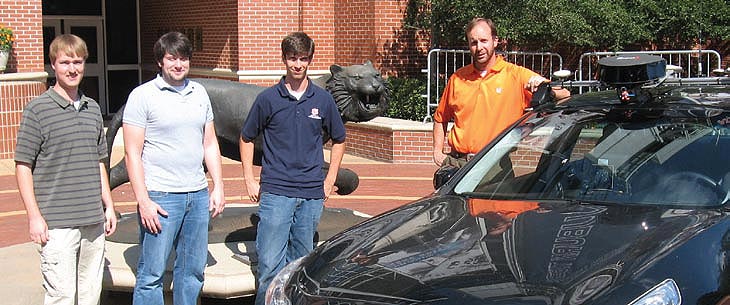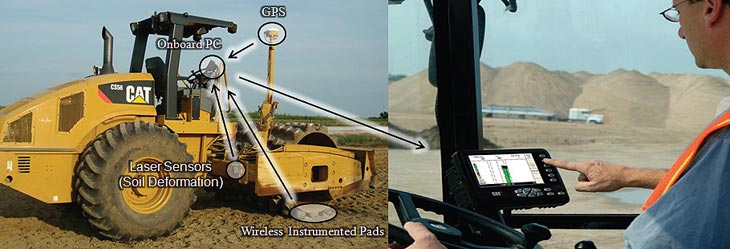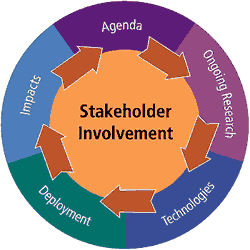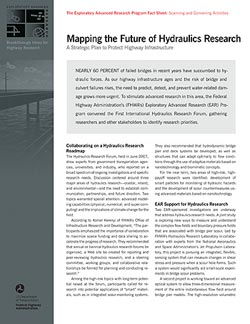U.S. Department of Transportation
Federal Highway Administration
1200 New Jersey Avenue, SE
Washington, DC 20590
202-366-4000
Federal Highway Administration Research and Technology
Coordinating, Developing, and Delivering Highway Transportation Innovations
| REPORT |
| This report is an archived publication and may contain dated technical, contact, and link information |
| Publication Number: FHWA-HRT-11-034 Date: January 2010 |
Publication Number: FHWA-HRT-11-034 Date: January 2010 |
PDF files can be viewed with the Acrobat® Reader®
Since 2007, the Federal Highway Administration’s (FHWA) Exploratory Advanced Research (EAR) Program has funded over 35 research projects. With project durations ranging from 2 to 4 years, 2010 saw the first projects awarded under the EAR program nearing conclusion. Each of these projects includes a transition plan from research to next steps and more recent projects include measures of success. In March and April 2010 two workshops involving almost 100 researchers and stakeholders from different fields and sectors reviewed the work of a selection of these projects, and assessed which projects have the potential to lead to transformational improvements to plan, build, renew, and operate safe, congestion free, and environmentally sound transportation systems.
The EAR Program workshops featured 10 projects, categorized into the following topic areas: human behavior and travel choices for safety, human behavior and travel choices for planning, technology for assessing performance, integrated highway system concepts, and nanoscale research. Project leads and researchers provided participants with project background, progress, and discussion on potential funding sources for continued investigation.
|
Nanotechnology particle structure. © iStockphoto/Anterovium |
|
“The support of the FHWA’s EAR Program for our project has provided us with an opportunity to explore the ability to integrate current on-board vehicle sensors to investigate ways to improve lane positioning for active safety systems,” says Dr. David Bevly at Auburn University. “The EAR Program funding has enabled us to fund three graduate students to obtain their MS degrees (pictured) and moving forward we now hope to further the research by integrating additional measurements such as DSCR ranges, visual odometry, and road signature to improve the performance and robustness.” |
| The Auburn University research team led by David Bevly (right). |

|
|
© Auburn University |
Two of the research projects are highlighted here as an example of general workshop discussion; the 3-year California PATH Program project, and the 2-year Colorado School of Mines project.
|
Truck platooning could greatly improve fuel efficiency.  © iStockphoto.com. |
Working in cooperation with California Department of Transportation, the California PATH project at the University of California, Berkeley, aims to improve traffic flow by calculating and communicating speed guidance directly to individual drivers; achieve closer coordination, shorter vehicle separation gaps, and higher effective lane capacities through vehicle–vehicle communication, vehicle–infrastructure communication, and cooperative adaptive cruise control; and improve heavy-truck fuel consumption and double the capacity of truck-only lanes by forming and maneuvering automated three-truck platoons.
The cooperative adaptive cruise control results presented at the workshop demonstrated that in a simulation of 100 percent market penetration, lane capacity went from 2,000 vehicles per hour to over 4,000 vehicles per hour. However, there were a number of scientific and engineering questions raised, for example the cooperative adaptive cruise control system requires development of new software algorithms to avoid the system making people uncomfortable with small gaps. Early simulations showed the ability of double-lane capacity with a 0.5-second gap, but the issue of driver comfort and acceptance remains an ongoing concern. Further simulations are anticipated to simulate gaps and achievable lane capacity; in addition the team will test vehicle coupling and multiple vehicles with differing performance in traffic to prove string stability.
Active Traffic Management results also showed promise based on simulations using variable speed limits to maximize effective highway capacity. The system is able to probe vehicle data and transmit speed advisories to the vehicle to indicate the appropriate speed to travel on the highway to maximize the flow. However, there is an ongoing challenge to convince transportation and law enforcement officials that Active Traffic Management is desirable. Further ramp-metering coordination strategies are to be tested, and the team plans to develop coordination between freeway ramp metering and arterial traffic-signal control.
Finally, the project’s Automated Truck Platoon concept was discussed. An experiment involving two trucks coupled electronically produced energy savings of 10 percent for the lead vehicle and 15 percent for the following vehicle. The results showed truck platooning has the potential to greatly improve the number of trucks moving through a lane per hour, but software robustness is a key focus at this time, particularly when working with the average truck’s three braking systems.
The Colorado School of Mines project builds on research and practice in Europe, where continuous compaction control and intelligent compaction of soil were developed and are now in widespread use.
Researchers are modeling a breakthrough approach and developing a prototype system to continuously measure soil modulus through its relationship with the contact force-displacement response of individual roller pads. Subgrade modulus is the key parameter used in pavement design and in performance-based quality assurance. If this system proves accurate and reliable, it would be significantly superior to the current practice of spot testing less than 1 percent of a compacted area.
Latest project results were presented at the workshop, highlighting that the project has completed finite element analysis modeling of pad – soil interaction mechanics and instrumented roller pads and conducted laboratory testing of instrumented pads and pad-soil interaction. Several questions remain, and workshop discussion focused on how much variation was built into the project’s soil model and whether the measurements obtained were in fact reliable proxies for soil density and soil strength under different soil and moisture conditions. The team is now aiming to establish the correlation between desired performance and the data collected. Also, it was concluded that if pad-foot intelligent compaction is shown to offer more consistent and reliable compaction, that can result in longer lived highways and lower, or equal, life-cycle costs, it should be adopted.
Finally, ongoing field demonstrations will be needed to confirm the reliability of measurements in a variety of soils, but mapping a deployment strategy will be the project team’s immediate action. It was generally felt that the technology would be more readily adopted in another area of construction and then later by the highway industry.
|
An overview of a padfoot roller and driver interface. 
© Caterpillar, Inc. |
|
The Innovation Life Cycle  Source: FHWA. |
The EAR Program-funded projects are part of a larger research and development cycle designed to move from basic research through applied research, field testing and pilot deployment, and broad implementation and adoption. Some of the research supported by EAR Program funds may lead to applied or commercial technology development. Other projects may provide foundational information about material properties or human behavior, suggest new models or algorithms, develop tools for use in conduction research, or lead to completely unexpected questions. The FHWA’s research and technology innovation life cycle illustrates that research and technology development are not insular activities, but integrated processes that together constitute a system.
Following general workshop discussion, a number of common issues emerged among the groups. These centered around the research life cycle, communicating the value of exploratory advanced research, and continued project funding. It was felt that there is a general need to better describe the research and deployment cycle specific to highway transportation and possibly to highway research fields, such as materials or system planning. Research life cycle diagrams show a very linear, chronological process but it is not necessarily that way in reality. For example there is often a lot of back and forth between parties as issues are uncovered that need investigating. Overall it was felt that the EAR Program has a great understanding of what the expectations should be at the earlier stages of research and it allows room for unexpected results and a degree of flexibility for overcoming difficulties.
|
Example of an EAR Program fact sheet.  Source: FHWA. |
Communicating the value of research was another key topic to emerge during the workshop discussions and something that the National Cooperative Highway Research Program Report 610: Communicating the Value of Transportation Research focuses on in detail. Different groups will be interested in research, depending on where the research is in the overall life cycle, so there is a real need to identify audiences and a research deployment path specific to each product and industry. Once identified, getting information into an appropriate format to disseminate to the proper audiences is an important step. The communication strategy should lay out a future scope of work to interested States and to potential manufacturers so they can see what their roles and responsibilities would be moving forward.
One of the most important aspects of communicating research discussed at the workshops was the ability to demonstrate things that people have not been able to experience before. Paper presentations can only deliver so much, but actually being able to see the approach and technology, particularly in the exploratory research area, is very powerful. This was seen in the California PATH adaptive cruise control project, where stakeholders could very quickly see and understand the implications for traffic stability right from the driving seat.
Getting to the end of the EAR Program schedule does not mean the end for many of these projects. The issue of moving forward and funding continued research and deployment was a key area of discussion. It is clear that there is a need to plan how projects can move forward, rather than just searching for the next stage of funding.
Factors that may influence how research may move forward include the organization of the research team, its partners, and their host institutions (academic, business, Government), the type of research and research products (reports, data, models, software, tests, equipment), stakeholders who would be interested in the research, what other groups are working on similar issues and approaches, and the availability of funding.
One approach is to work exclusively with one manufacturer during the initial research, providing an incentive for the manufacturer to invest in continued deployment of any potential product, although this approach could be seen as giving an unfair advantage to one company over others. Another issue raised is that State DOTs may not adopt specifications for a product or process licensed to only one manufacturer or written to favor one manufacturer.
For some projects, workshop participants favored a “lead states” type of approach over attempting to implement nationally from the beginning. Engaging the more forward-looking States to act as champions was seen as the best approach. Demonstrating field reliability is a key step, once a deployment strategy has been mapped out to ensure obstacles are fully considered in advance of finding partners for deployment.
Some results may also require staged implementation, the example of continuous compaction control technology was given in this case. The easiest, most incremental use is simply to use the roller to identify the weakest area for acceptance based on spot testing. In the second use, acceptance is based on the roller measurements after roller measurement and spot test data are correlated based on acceptance criteria. The following additional methods to support further research and development of technology were considered:
For further information on funding programs visit www.trb.org/researchfunding. For more information on FHWA’s EAR Program and future opportunities, contact David Kuehn at FHWA, 202-493-3414 (email: david.kuehn@dot.gov).
|
What is the Exploratory Advanced Research Program? FHWA’s Exploratory Advanced Research (EAR) Program focuses on long-term, high-risk research with a high payoff potential. The program addresses underlying gaps faced by applied highway research programs, anticipates emerging issues with national implications, and reflects broad transportation industry goals and objectives. To learn more about the EAR Program, visit the Exploratory Advanced Research Web site at www.fhwa.dot.gov/advancedresearch. The site features information on research solicitations, updates on ongoing research, links to published materials, summaries of past EAR Program events, and details on upcoming events. For additional information, contact David Kuehn at FHWA, 202-493-3414 (email: david.kuehn@dot.gov), or Terry Halkyard at FHWA, 202-493-3467 (email: terry.halkyard@fhwa.dot.gov). |